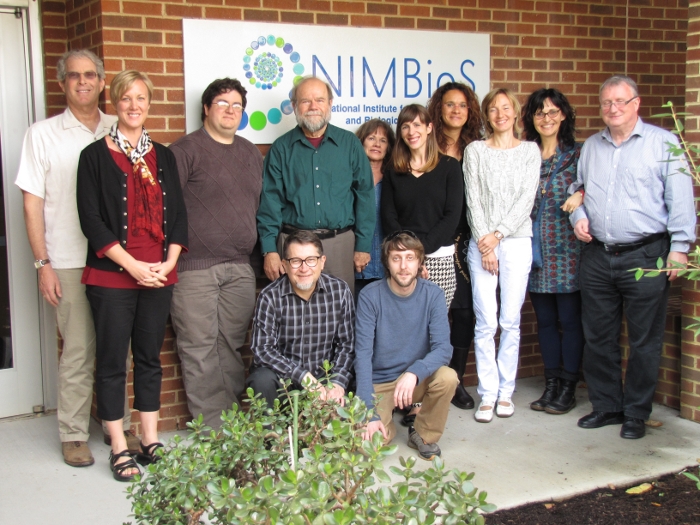
Meeting 3 of the Working Group on Play, Evolution, and Sociality. (Back row, L to R): M. Mangel, H. Fouts, B. O’Meara, G. Burghardt, B. Smuts, K. Lewis Graham, G. Cordoni, M. Rehakova, E. Palagi, P. Hammerstein. (Front row, L to R): S. Pellis, J. Auerbach. Not pictured: J. Schank, E. Akcay
Research on what motivates play in mammals, both human and non-human, has been published in a special issue of the journal Behaviour. The nine papers in the special issue are products of the NIMBioS Working Group on Play, Evolution and Sociality.
The nine papers in the special issue include:
- Motivation of play: from ethological to neurological perspectives by Elisabetta Palagi and Hillary N. Fouts
- Work-themed play among young children in foraging and farming communities in Central Africa by Hillary N. Fouts, Carin L. Neitzel and Lauren R. Bader
- Affiliation, dominance and friendship among companion dogs by Rebecca K. Trisko, Aaron A. Sandel and Barbara Smuts
- Play fighting in Visayan warty pigs (Sus cebifrons): insights on restraint and reciprocity in the maintenance of play by Sergio M. Pellis and Vivien C. Pellis
- Aggression and hierarchical steepness inhibit social play in adult wolves by Giada Cordoni and Elisabetta Palagi
- Motivation, development and object play: comparative perspectives with lessons from dogs by Gordon M. Burghardt, Julia D. Albright and Karen M. Davis
- Metacommunication in social play: the meaning of aggression-like elements is modified by play face in Hanuman langurs (Semnopithecus entellus) by Marek Špinka, Marie Palečková and Milada Řeháková
- A brain motivated to play: insights into the neurobiology of playfulness by Stephen M. Siviy
- Stone handling, an object play behaviour in macaques: welfare and neurological health implications of a bio-culturally driven tradition by Charmalie A.D. Nahallage, Jean-Baptiste Leca and Michael A. Huffman
The full special issue can be found at http://booksandjournals.brillonline.com/content/journals/1568539x/153/6-7.
In a series of meetings from 2011 to 2013, the NIMBioS Working Group brought together mathematicians, anthropologists, zoologists, neuroscientists, ecologists, psychologists and other top experts to examine play as a window into cognitive evolution and the rules of sociality.
Until the Working Group was established, the field lacked a mathematical and computational approaches for understanding how play evolves. Using mathematical tools, the group aimed to uncover factors predicting the dynamics, occurrence and trajectory of play in the animal kingdom, as well as explore the ecological, psychological and life history factors that facilitate and maintain play.
The special issue is the second from the Working Group. The first was Adaptive Behavior on the origin and evolution of play issued last November.
